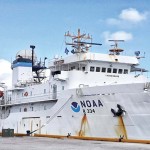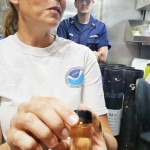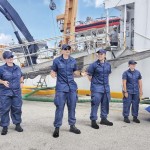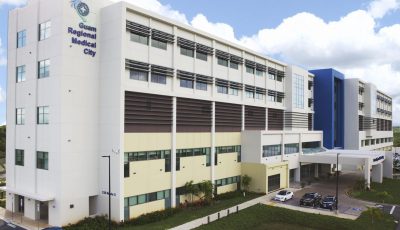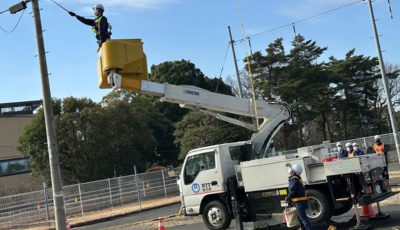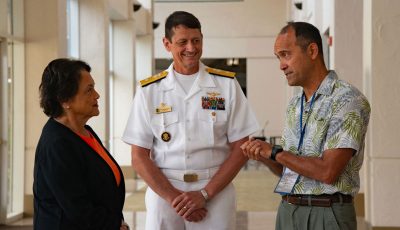NOAA ship docks on Saipan
- The Hi’i alakai ship at the Port of Saipan before heading to the Northern Islands to conduct more marine ecosystem research. (Bea Cabrera)
- Scientist Kelly Bearden shows a specimen of a snapping shrimp. “They make the cracking sound like Rice Crispies underwater,” she said. (Bea Cabrera)
- Terril Efird, center, and the rest of the ENS team brief the visitors at the entrance of the ship. (Bea Cabrera)
National Oceanic and Atmospheric Administration’s ship Hi”ialakai has docked on Saipan and will be on island for a couple of days before proceeding to the Northern Island to conduct more marine ecosystem research.
Hi’ialakai is a Hawaiian word that means embracing the pathway to the sea and the ship is definitely living up to its name in terms of research and study.
The ship’s main mission is to conduct scientific diving operations that allow the team of scientists to do underwater ecosystem mapping, coral reef monitoring, fish studies, and update nautical charts. The ship has a fish team, oceanographic team, and habitat team composed of scientists that makes sure the projects are carried out.
Terril Efird, from the ship’s Emergency Notification System, gave a brief history of how the ship became the Hi’ialakai of today.
“The ship was built during the Cold War era late 1984 as a sub-listening vessel in the North Sea. At the end of the Cold War, the ship was given to the Coast Guard who used it for drug interdiction. Later on, they realized that a 10-knot ship is not a great speed for drug interdiction. Since the ship was a sub-listening vessel (it makes no extra sound entering the water) and it can take on scientific instrumentation, it was a great research platform for fisheries and mapping.”
The ship is self-sufficient. It houses the crew and scientists in comfortable bunks, a mess hall that manages to house 50 people, laboratories, a pressurized chamber called the hyperbaric chamber. “We operate in some remote places in the Pacific so we are our own emergency notification system. We have a public health service medical officer, hospital, 911, firefighters.” Efird added.
Kelly Bearden, marine research coordinator, is in charge of studying invertebrates. “We use these gray structures called autonomous monitoring structures or arms units. They are essentially like a reef condo/hotel. We attach them to a reef let it sit there for three years. When we return, we encapsulate them and bring them to the surface. It houses mobile fauna not greater than 2mm in size like fish, crabs, worms, and snails.”
On what gives the crew satisfaction after a day of research and study, NOAA Fisheries chief scientist Kelvin Gorospe said, “I find satisfaction in the educational component of our work. Reefs are overlooked. They are important eco-biologically. Corals are so sensitive to temperature and water chemistry changes. Educating the children, the next generation, about these things is what keeps us love what we do.”
Brilliant Star School grade 3-6 students joined the tour.
“Seeing the ship and learning what it does is a good learning opportunity for the kids. They can follow the trips and the scientists on line. They can see what the scientists are working on: research and surveying. They can see it online now in the tour, they will experience this in real life,” said Brilliant Star principal Richard Sikkel.
The result of the days, months, and years of research go to public use and benefit.
Steve Mckagan, fisheries and coral reef biologist, said, “The coral reef program have their own website where they post all of the information that they gathered. You can keep track of the studies and even contact the scientists involved. The public can access this data portal for free.”
The ship started its journey this year from Honolulu, made a trip to Jarvis Island, Baker Island (down the Equator), back to Wake Island, and finally came to Guam. It has spent 21 days working around Guam, Saipan, Tinian, Rota, and surrounding islands.
Through all of these voyages, commanding officer and ship captain Elizabeth Kretovic leads the ship. “I’ve been running the ship for a year and a half now. Basically, all the responsibility of the ship is on my shoulders. I am in charge of the safety on the ship and make sure that all mission gets completed safely and accurately.”
On Saturday, May 27, the ship will head on and continue its research and study to the Northern Islands. It will spend 27 days around the islands to collect samples and visit instrumentations. After which, the ship and its crew will head back to its mother port in Honolulu.



